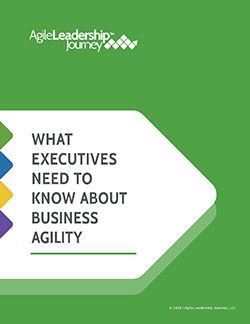New Ebook Available: What Executives Need to Know About Business Agility
In today’s market, executives are under increasing pressure to not only respond to market changes but to disrupt the market themselves. It’s the only way to keep competitors on the back foot and to continually attract and capture new customers. That’s why, when you walk into any executive boardroom today, you’ll hear people discussing business agility.
There’s a problem, though.
The term business agility has become muddled. Stakeholders are getting tangled in rhetoric, confusing definitions, and conflicting expectations. If executives want to not only understand business agility but enable its growth, they need to move past this confused messaging. Their goal must include a shared understanding of business agility, an alignment of what agility means specifically for their business, and to prepare the organization – employees and stakeholders included – for an uneasy journey ahead.
If you’re in a situation similar to the one these executives find themselves in, let’s fix that.
Business Agility in a VUCA World
In this new ebook, What Executives Need to Know About Business Agility, we’ll review the fundamentals of business agility, why pursuing business agility is critical in today’s VUCA environment, and why the factors driving you toward business agility might not fit the typical mold.
We’ll explore why it’s important to understand that business agility is not a goal to be achieved, but a fundamental competency that every organization should achieve. We’ll discuss what benefits organizations with high levels of business agility can expect, as well as what the primary barriers to business agility are so you can reflect upon your own organization and anticipate roadblocks.
For every roadblock, there is a solution.
What Executives Need to Know About Business Agility offers recommendations for how to improve business agility inside your organization, such as how to get your finance department involved earlier in the process, and why it’s important to align customers over departments.
Finally, we’ll discuss the process of actually navigating toward business agility – specifically, why it’s important to not rely on tools, but instead to evolve a bespoke approach to business agility that suits your organization and the state of its agility.
Navigating Your Organization Toward Business Agility
After reading this ebook you’ll have a clearer understanding of what executive leaders are facing as they try to create and improve agility within their organizations. If you’re an executive leader, you’ll have the vocabulary you need to discuss business agility with your colleagues, and a better picture of what steps are most valuable to you on your journey toward business agility (and which to avoid).
Most importantly, you’ll have cleared out the fog and gained the knowledge you need to begin building those critical capabilities without getting tangled up in rhetoric.
Sound good? Let’s get started.
About the Author
Pete Behrens is a leadership coach and the founder of the Agile Leadership Journey, an organization, curriculum, and community devoted to improving leaders and their organizations. As an engineer by profession, Pete now guides leaders and organizations to be more focused, responsive and resilient to change.
Pete led the development of the Certified Enterprise Coaching (CEC) and Certified Agile Leadership (CAL) programs for the Scrum Alliance, is the creator and host of the (Re)Learning Leadership podcast, and provides leadership and organizational coaching through his company Trail Ridge.
Connect with Pete on LinkedIn.








